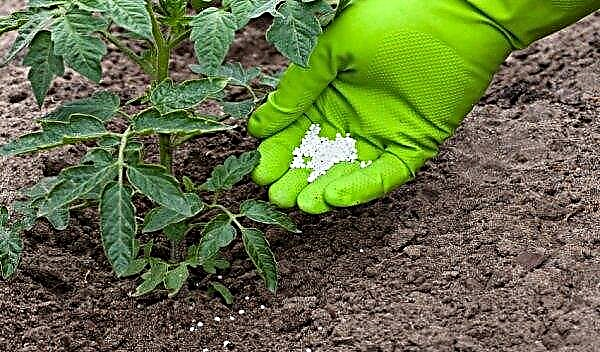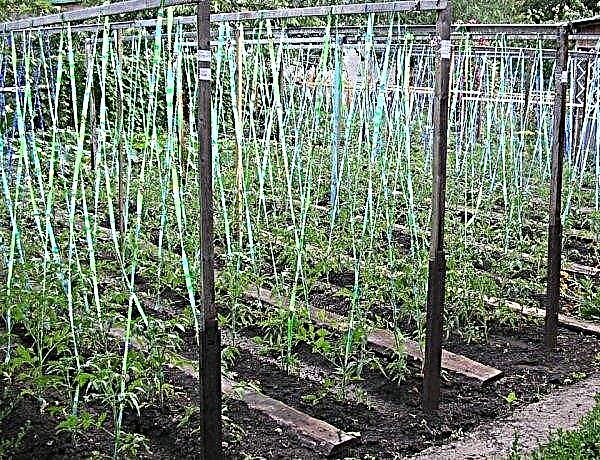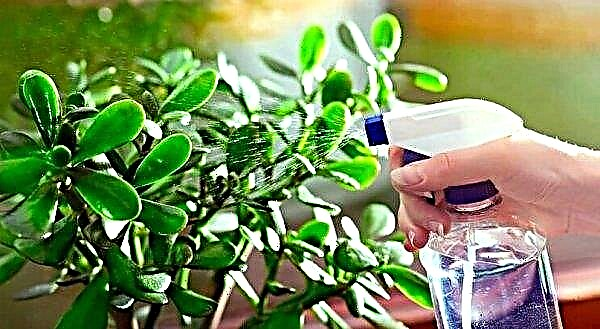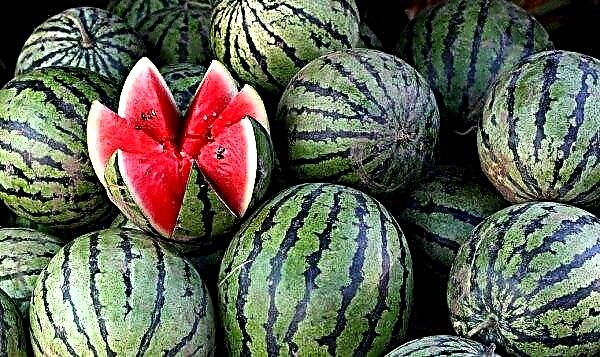A huge number of different types of succulents are grown in the world, among which brigamy is often distinguished - a small palm tree in a pot that can decorate any interior. This article will consider a detailed description of brigamia, the features of plant care, the possibility of reproduction, as well as problems encountered during the cultivation.
Botanical description of the plant
Brigamia belongs to the succulents from the Kolokolchikov family, which store water in the main stem, in the thickest part. In nature it reaches 5 meters in height, in conditions of home cultivation - a meter in height. Blossoms often only in the natural habitat in the spring (September-October), occasionally blooms at home.
| Root system | Well developed, grows no more than 10-15 cm in depth. |
| Stem | Powerful, fleshy, has the shape of a bottle, at the top is a dense rosette of leaves. The young plant has a smooth trunk, which eventually acquires a grayish tint, and scars form in place of fallen leaves. |
| Leaf shape | Oblong, 30 cm in length, similar to cabbage leaves. |
| Leaf color | Glossy, saturated light green. |
| Flower shape | The flowers are small, have 5 pointed petals. |
| Flower color | Light yellow. |
| Fruit shape | Small, rounded, up to 2 cm long and 1.5 cm wide. |
| Fruit color | Dun. |
| Fruit flavor | Not eatable. |
Main types
Brigamy plant is of two types:
House growing conditions
Like all indoor plants, brigamia requires special growing conditions that relate to the location of pots and the indoor climate.
Did you know? In the homeland of Brigamia, Hawaii, the local population in ancient times used the plant stem for medicinal purposes.
Location
Brigamia loves the sun very much, so placing the pot is better on the south side, right on the windowsill. This is especially true of the winter period, when the sun's rays are more gentle. In the summer, you need to be a little more careful so that the leaves do not suffer from burns. It is better if the sun's rays fall on the plant in the morning and evening, and during the lunchtime scorching sun the plant is better to shade a little. In summer, you can plant brigamy in the garden, put on a balcony or terrace with diffused sunlight. In the open air, the plant feels much better, so if possible, at the end of spring, the pot can begin to be taken out 2 hours a day outside, increasing the time every day by 2 hours. When the first cold weather sets in and the air temperature drops below +8 degrees at night, the plant is brought into the room. In early September, the plant begins to bloom, so that the flowering lasts longer, it is better to keep the pot indoors.
In the open air, the plant feels much better, so if possible, at the end of spring, the pot can begin to be taken out 2 hours a day outside, increasing the time every day by 2 hours. When the first cold weather sets in and the air temperature drops below +8 degrees at night, the plant is brought into the room. In early September, the plant begins to bloom, so that the flowering lasts longer, it is better to keep the pot indoors.
Important! During heavy rains, the pot is recommended to be brought into the room to avoid root decay.
Temperature
Due to the fact that brigamia grows in warm countries, the plant prefers a fairly high temperature - from +25 to +28 degrees. In the winter period, it is necessary to ensure that the air temperature does not fall below +15 degrees, since the root system can be supercooled and die.
Air humidity
The plant does not tolerate dry air. The optimal indicator for brigamia is a humidity level of 75%. In this regard, daily humidification is required using artificial humidifiers or by spraying leaves from a spray bottle.
Home Care
As for plant care, there are no particular difficulties in growing brigamy. However, regular care in the form of spraying, watering, fertilizing and transplanting should be present in order to protect the plant from possible problems with the development of the root system and stimulate the growth of green mass.
Watering
Considering that brigamia is a succulent and can accumulate the amount of fluid necessary for normal development, the plant practically does not suffer from the lack of watering. The situation is worse with regular waterlogging of the soil, which can lead to decay of the root system or plant stem. If you react in time and transplant brigamy into new soil by removing the rotten parts of the roots, you can save the plant, but if the rot begins to appear on the stems, it means that the root system has already decayed and the brigamy will die.
Important! Brigamia can feel normal without watering a month or more. The maximum interval between watering is 42 days.
Before watering the flower, the soil is checked with a wooden stick: if the soil is completely dry (to the very bottom of the pot) - the plant is watered. Usually in the summer, the flower is watered once a week, in the winter - 1-2 times a month. Water is poured directly under the root. Water for irrigation is slightly heated so that the temperature is 4 degrees above room temperature. In addition, the leaves must be sprayed daily from a spray bottle.
Top dressing
For normal development, brigamy is fed 1 time per month with special purchased fertilizer for cacti. Depending on the manufacturer, the instructions for using top dressing are different, so it is not advisable to give any recommendations. It is important only before the first use of top dressing to carefully study the instructions and follow it, observing the time frame.
Transfer
For the first 3-4 years, the plant actively increases the root system and the terrestrial part, so they try to transplant brigamy every year. At the 5th year of life, the flower stops growing, so a transplant is required once every 2-3 years. For each transplant, use a pot slightly larger in diameter than the previous one.
Not very deep pots are chosen, since the root system of the plant is located in the upper layers of the soil. Be sure to transplant using high-quality soil for succulents (purchased in specialized stores) and provide a good layer (at least 4 cm in height) of drainage (expanded clay). A transplant is best done in the spring.
Recommended Reading

The Brigamia transplant process is as follows:
- Initially, a mixture is prepared for transplantation, for this, the purchased substrate is mixed with sand 1 to 1.
- Expanded clay is poured into the bottom of a new pot with a layer of 4 cm, a little cooked earth mixture is poured on top.
- Carefully remove the brigamy from the old pot so as not to damage the roots.
- Slightly destroy the earthen lump formed around the root system, inspect the roots.
- Damaged, dead, rotten roots are removed with sharp scissors and sprinkled with crushed charcoal.
- Place the plant in a new pot and pour the finished soil mixture, lightly pressing it with your hands to fix the brigamy.
Breeding
Brigamy can be propagated in two ways - seeds and cuttings. Let's consider each of them in more detail.
Did you know? In the wild, brigamy is an endangered plant and continues to breed only thanks to the activities of scientists. As a result of the massive population of the islands - the birthplace of brigamy - almost all insects that pollinated rare flowers died, so seed reproduction became impossible.
Seeds
To propagate brigamia seeds, it is necessary to resort to self-pollination of flowers, as a result of which seeds are formed very rarely, therefore this method is not used.
Cuttings
To propagate brigamy in this way, large, strong, beautiful leaves are cut from the upper part of the plant (a layer of young leaves). Cut with a sharp knife so that the stalk is at least 8 cm long. The cut leaf is left for 2 days at room temperature so that the cut dries out a little. Next, you need to build a small greenhouse, for this, a leaf is immersed in a pot filled with sand, sprayed regularly, and covered with a transparent plastic bag on top. Use warm water for spraying, the temperature of the water should be 4 degrees above room temperature. Air the greenhouse daily by removing a plastic bag for 1–2 hours.
Next, you need to build a small greenhouse, for this, a leaf is immersed in a pot filled with sand, sprayed regularly, and covered with a transparent plastic bag on top. Use warm water for spraying, the temperature of the water should be 4 degrees above room temperature. Air the greenhouse daily by removing a plastic bag for 1–2 hours.
Growing difficulties
When growing brigamia, problems can occur that are characterized by:
- shedding flowers and buds - in this case, the main cause of the problem is caused by a change in the location of the pot and a lack of sunlight. To normalize the flowering process, place the pot in a sunny place;
- damage to the root system - the reason is the waterlogging of the substrate. To prevent decay, it is recommended to observe the watering regime, and if the root system begins to rot, then it is necessary to immediately transplant with the preliminary removal of rotten parts of the roots;
- dumping leaves - Possible causes of the development of the problem: movement of the pot, temperature changes. It is necessary to deal with the problem based on the reason: put the pot in a sunny place or adjust the temperature regime;
- the appearance of spider mites on the leaves, which provokes yellowing of sheet plates and their deformation. To solve the problem, brigamy is treated with a soap solution (30 grams of laundry soap is used per 1 liter of water). Spray 2 times a day until the problem disappears. If the soap solution does not help, then the plant is treated with insecticides (Actara or Actellik) according to the instructions.

Thus, it is not difficult to grow brigamy at home, the main thing is to follow the recommendations for caring for the plant and maintain the recommended indoor microclimate.













